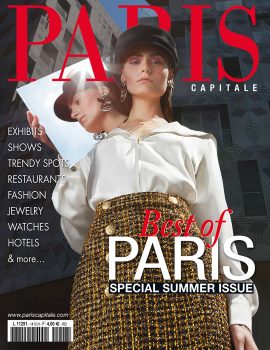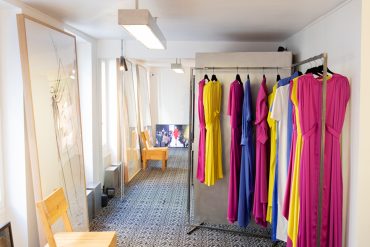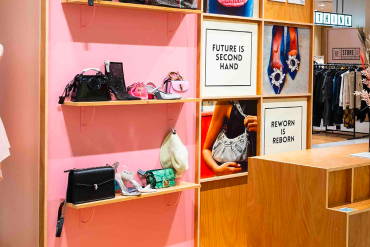The boutique section includes all the worlds of the brand: women’s and men’s fashion, beauty, home, watchmaking and jewellery. We note the creations with the assertive femininity designed by Maria Grazia Chiuri, some of which are exclusive with a personalization service offered for bags and some carefully selected clothes. A precious setting welcomes the collections of jewels and timepieces designed by Victoire de Castellane, who, upon his arrival at Dior, changed the codes of the Place Vendôme. The human space gives the full measure of the success of the collections designed by Kim Jones who reinvented the masculine silhouette of the brand. The Dior Maison universe values the French art de vivre and collaborations with designers and interior architects like Pierre Yovanovitch who signs original objects. All adjoin one of the three gardens designed by the landscaper Peter Wirtz. Not to mention the contemporary boudoir dedicated to beauty and perfumes whose walls are punctuated by roses carved in the material. Behind a hidden door, a treatment and make-up booth invites you to relax. The codes of the house have been reinterpreted without ever pouring into the too “demonstrative” thanks to the talent of Peter Marino, the star architect who knows perfectly the world of luxury and is a faithful of the house. He was entrusted with his third transformation of Dior’s legendary address. «This project is different from the others, of course, because it was the first Christian Dior boutique to present a historic façade of the eighteenth century», explains the architect. The idea was to open the spaces, to bring in the light and nature so dear to Christian Dior. The photos of him in the garden of his house in Granville always struck me; he seemed so happy. I really wanted to create a winter garden full of flowers on the ground floor.» Many works underline once again the house’s attachment to the arts and appear as a tribute to the life of Monsieur Dior who was a gallery owner before embracing the career of designer. Isa Genzken’s Rose II animates the main staircase, Paul Cocksedge’s La Bourrasque overlooking the rotunda, reinterpreting the idea of foliage in an abstract way. In the final touch, the carefully chosen furniture is notably signed by Joaquim Tenreiro, Hans Olsen, Gio Ponti, Ado Chale, Claude Lalanne, Delos & Ubiedo, Gabriella Crespi. The vintage pieces respond to contemporary creations, an 18th century sofa to American pieces or furniture from the 1940s and 1950s of Joseph-André Motte. But this mythical address wishes to become above all a place of life. In addition to the haute couture workshops that have returned to the building, a new haute joaillerie workshop has just settled there. This experience is also based on an ultimate luxury: the first and only Dior Suite, an exclusive apartment that “gives the keys” to its occupants all over 30 Montaigne, with private meals and visits possible at any time, even at night, to home workshops. It is murmured that it is already reserved by ultra-loyal customers! The address at 30 Avenue Montaigne is now as historic as it is unusual.
Dior Gallery, at the heart of creation
If Monsieur Dior’s passions, such as gardening, fashion, French lifestyle, flowers and perfumes, refined cuisine with sweet treats and savoury recipes, are highlighted in the shop, you have to cross the entrance of the Dior Gallery to get to know his life and the success story of the house he founded. The visit of this 2,000 m2 space, which pays tribute to its activity as a gallery owner before entering fashion, is essential. First aesthetic shock: an exceptional collection of more than 1,800 miniaturized objects from the Dior universe designed in 3D printing, all in shades of color enliven the walls of its staircase. The place benefits from the daring and demanding scenography of Nathalie Crinière who went so far as to reconstitute Monsieur Dior’s office and the original fitting room of the couture house. It is no less than thirteen rooms animated with dresses, accessories, films, archive images and photos that punctuate this walk holding the fairy tale. The public plunges into the life of the designer, in the boiling of the workshops and the parades, discovers the Dior look, the artistic affinities of the house, the women-flowers with exceptional models signed by Monsieur Dior and after him Yves Saint Laurent, the dresses of stars such as the navy blue worn by Princess Diana at the Met Gala in 1996, the influences of travel and the designers who were and are currently guarantors of the Dior stylistic signature, Yves Saint Laurent, Raf Simons, John Galliano and Maria Grazia Chiuri. We must dwell on an incredible cabinet of curiosities in which are meticulously displayed, in windows, accessories and heritage objects including the bottle of Miss Dior taking the shape of the Maltese bichon of the couturier, Bobby, created especially for the Christmas celebrations of 1952. The tour ends with the magnificent ballroom, set in majesty by fairy light games. The journey is stunning. A cream in the Café Dior that welcomes the visitor at the end of the race… the time to return to reality.






